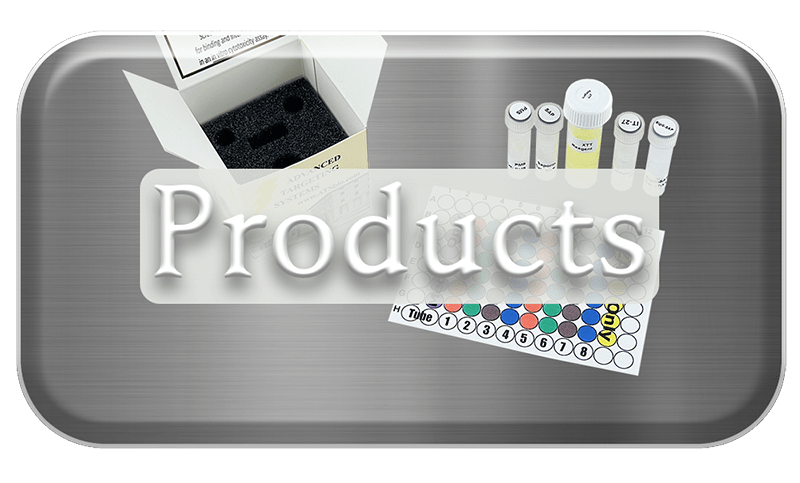Immunology
The Advanced Targeting Systems targeting technology provides immunologists with the tools to identify, visualize, and or eliminate specific cell types. Some examples of scientific studies using ATS products include B-Cell targeting, T-cell targeting, depletion of inflammatory dendritic cells, increasing the success rate of transplantations, and the study of diseases of the immune system.
Use the links below to examine the ATS toolbox for solutions to your immunological challenges.





Products
NGFr (ME20.4, p75) Mouse Monoclonal (Cat. #AB-N07)
The p75 neurotrophin receptor (p75NTR), also known as the low affinity nerve growth factor receptor, binds nerve growth factor, brain-derived neurotrophic factor, neurotrophin-3 and neurotrophin-4 with varying specificities. The p75NTR plays an important role in neurotrophic factor signaling and has been shown to modulate the susceptibility of selective cellular populations to programmed cell death.
Anti-CD117-SAP (Cat. #IT-83)
CD117 is a transmembrane, tyrosine kinase growth factor receptor also known as c-Kit and mast/stem cell factor receptor (SCFR). It binds the c-Kit ligand (also known as steel factor, stem cell factor, and mast cell growth factor). CD117 is expressed on hematopoietic stem cells (including multipotent hematopoietic stem cells, progenitors committed to myeloid and/or erythroid lineages, and T and B cell precursors), mast cells, and acute myeloid leukemia cells. CD117 plays an essential role in the regulation of cell survival and proliferation, hematopoiesis, stem cell maintenance, gametogenesis, mast cell development, migration and function, and in melanogenesis.
Anti-CD117-SAP is a chemical conjugation of rat monoclonal CD117 antibody (Clone 2B8) and the ribosome-inactivating protein, saporin. Anti-CD117-SAP specifically eliminates cells that express CD117 in mice.
Streptavidin-ZAP (Cat. #IT-27)
Streptavidin-ZAP converts biotinylated materials into targeted toxins. Streptavidin is a tetrameric protein (molecular weight 53 kDa in its recombinant form), with each subunit able to bind a single biotin molecule. The bond between streptavidin and biotin is rapid and essentially non-reversible, unaffected by most extremes of pH, organic solvents, and denaturing reagents. It is the strongest known noncovalent biological interaction (Ka = 1015 M-1) between protein and ligand. The streptavidin used to make Streptavidin-ZAP contains no carbohydrate group and has a neutral isoelectric point, which therefore reduces the nonspecific binding as compared to avidin. A variety of molecules, including lectins, proteins, and antibodies, can be biotinylated and reacted with streptavidin-labeled probes or other detection reagents for use in biological assays.
Streptavidin-ZAP is a chemical conjugate of streptavidin and the ribosome-inactivating protein, saporin. It converts biotinylated materials into targeted toxins.
Mac-1-SAP
CD11b is an alpha subunit of Mac-1, also known as CR3. CD11b is the receptor for the C3bi fragment of complement. This receptor is involved in bacterial phagocytosis. A reduction in neutrophil CD11b expression after severe traumatic injury correlates with increased septic complications. CD11b is a component of integrins, important for adhesion of neutrophils to surfaces. Mac-1-SAP recognizes the Mac-1 (CD11b) receptor in mouse and human. Mac-1-SAP is excellent for removing contaminating macrophages from primary cultures to determine their role(s) in autoimmune diseases and in degenerative diseases such as Alzheimer’s.
Mac-1-SAP is a chemical conjugate of the rat monoclonal antibody to CD11b (the receptor for C3bi) and the ribosome-inactivating protein, saporin. It eliminates Mac-1 positive (CD11b positive) cells in mouse and human.
Antibodies
Browse our list of antibodies for applications including immunostaining and flow cytometry.
References
T-cell reconstitution without T-cell immunopathology in two models of T-cell-mediated tissue
destruction.
Penaloza-MacMaster P, Masopust D, Ahmed R (2009) T-cell reconstitution without T-cell immunopathology in two models of T-cell-mediated tissue destruction. Immunology 128:164-171. doi: 10.1111/j.1365-2567.2009.03080.x
Summary: Although antigen-specific T cells are vital to adaptive immune responses, they also contribute to a variety of diseases. In this work the authors examined the possibility of selectively removing epitope-specific T cells while preserving immune function. Biotinylated MHC class I tetramers were combined with streptavidin-ZAP (Cat. #IT-27) and used in a mouse transferable T-cell-dependent neurological disease model. This technique resulted in a dramatic reduction in targeted antigen specific T cells with no observable bystander toxicity.
Immunological barriers to haematopoietic stem cell gene therapy.
Charlesworth CT, Hsu I, Wilkinson AC, Nakauchi H (2022) Immunological barriers to haematopoietic stem cell gene therapy. Nat Rev Immunol 1-15. doi: 10.1038/s41577-022-00698-0
Objective: This review article attempts to encourage more research to address the immunological barriers to haematopoietic stem cell based gene therapies.
Summary: The authors lay out the history and clinical trials of hematopoietic stem cell gene therapy and then discuss the challenges of both innate immunity and adaptive immunity.
Usage: This review mentions a publication that used Anti-CD117-SAP to ablate hematopoietic stem cells.
Immunological properties of neural crest cells derived from human induced pluripotent stem cells.
Fujii S, Yoshida S, Inagaki E, Hatou S, Tsubota K, Takahashi M, Shimmura S, Sugita S (2019) Immunological properties of neural crest cells derived from human induced pluripotent stem cells. Stem Cells Dev 28(1):28-43. doi: 10.1089/scd.2018.0058 PMID: 30251915
Usage: IHC; 1:200 dilution
Selective hematopoietic stem cell ablation using CD117-antibody-drug-conjugates enables safe and
effective transplantation with immunity preservation.
Czechowicz A, Palchaudhuri R, Scheck A, Hu Y, Hoggatt J, Saez B, Pang WW, Mansour MK, Tate TA, Chan YY, Walck E, Wernig G, Shizuru JA, Winau F, Scadden DT, Rossi DJ (2019) Selective hematopoietic stem cell ablation using CD117-antibody-drug-conjugates enables safe and effective transplantation with immunity preservation. Nat Commun 10:617. doi: 10.1038/s41467-018-08201-x
Objective: To investigate a safe and effective method for hematopoietic stem cell transplantation.
Summary: CD117-ADC selectively targets hematopoietic stem cells yet does not cause clinically significant side-effects.
Usage: The CD117-ADC was prepared by combining biotinylated anti-CD117 (clone 2B8) with Streptavidin–ZAP. A dose of 1.5 mg/kg of CD117-ADC (~12 µg Streptavidin-ZAP) optimally resulted in depletion of >99% of immunophenotypic and functional HSCs.
A rapid, pH-sensitive screening method to detect internalization of cell surface markers for development of antibody-based pharmaceuticals to treat brain tumors.
Shramm PA, Ancheta L, Higgins D, Lappi DA (2017) A rapid, pH-sensitive screening method to detect internalization of cell surface markers for development of antibody-based pharmaceuticals to treat brain tumors. Neuroscience 2017 Abstracts 566.24 / H7. Society for Neuroscience, Washington, DC.
Summary: Some of the most potent treatments for cancers have been antibodies to cell surface proteins that cause tumor cell proliferation. Examples are cetuximab (antigen: EGFR) approved for colorectal cancer and Trastuzumab (ERBB2) for breast cancer. These antibodies have more than one effect on the cancer cell, but one of the most important is that, upon binding to the cell surface antigen, the complex is internalized by so-called antibody mediated internalization. As such, the mitogenic cell surface protein no longer plays a role in cancer cell division. Despite the blood brain barrier challenging systemic treatment for brain tumors, intracerebroventricular injection can produce similar results. For example, Gholamin et al., (Sci Transl Med 9:381, 2017) and Kang et al. (Sci Rep 6:34922, 2016) reported down-regulation of brain tumor mitogenic agents through antibody-mediated endocytosis. The quick and efficient screening of antibodies that internalize effectively is vital for determining suitability of an antibody as a therapeutic targeting agent. Here we describe a method for the efficient determination of internalization of cell surface molecules by antibodies using a pH-dependent fluorescent reporter cross-linked to a secondary antibody in a plate-based assay with visualization of internalization in hours. This conjugate is comprised of an affinity-purified monovalent secondary antibody against both the heavy and light chain of human or mouse IgG and is conjugated to a pH -dependent fluorescent reporter. The fluorescence from this reporter increases intensity as the pH of its surroundings becomes more acidic, as evident when exposed to the environment inside a cell (thereby providing evidence of internalization). A successful assay protocol has been developed to provide an EC50 by way of a fluorescence-detecting plate reader, which could be used to explore antibody candidates as therapeutics in a quick and reproducible manner.
Articles
pHast Conjugates
pHast Conjugates are one of our pHastest tools for quantitative testing of your primary antibody’s specificity, binding, and internalization, providing results in 1 day.
Biotin-Z Kits
Use cell surface markers to bind and internalize molecules into specific cell types. Eliminating specific cell types can reveal the function of the cell and its impact on behavior.
Choosing the Correct Secondary Conjugate
Which products do I need to order? Helpful information for determining which product to use for your application.
ZAP Secondary Conjugates
ZAP conjugates are non-targeted saporin conjugates that “piggyback” on to your primary targeting agent (biotinylated material or antibody).
Targeting B Cells
How can I target B-cells? Which secondary conjugate should I use?
ATS makes secondary conjugates that use your primary antibody to target cells for elimination. Just mix your primary antibody with a secondary antibody conjugated to the ribosome-inactivating protein, Saporin, to screen your antibodies. The cells targeted by your primary antibody are eliminated.
Targeting Tools: Anti-6-His
The use of polyhistidine tags has become a popular method for protein purification, commonly used in the screening process as a tag for your protein or peptide of interest. Whether the material you are screening for is affinity purified or in crude bacterial extract, you will find our antibody suitable to your needs.
Saporin Uses in Immunology
One of the more common methods of using Streptavidin-ZAP is to couple the complex with biotinylated antibodies. However, there are also many instances of biotinylated ligands, peptides, and even biotinylated major histocompatibility complex (MHC) tetramers in immunology fields.
Videos
Biotin-Z Internalization Kit
Use cell surface markers to bind and internalize molecules into specific cell types. Eliminating specific cell types can reveal the function of the cell and its impact on behavior.
ZAP Antibody Internalization Kit
A description of the components in an Antibody Internalization Kit by Advanced Targeting Systems. This kit is used to screen antibodies for their specificity and ability to internalize. The technology uses a secondary antibody conjugated to saporin. Simply mix the Secondary ZAP conjugate with your primary antibody to make your own targeted toxin. Apply the targeted toxin to cells that express the receptor your antibody is targeting. Develop the cytotoxicity assay to determine whether your antibody recognizes the target receptor. This assay is used to screen multiple antibodies for the same target to determine which is the best antibody to continue development as a drug or research tool.
Protocols
Protocols
Find the ATS Protocols and calculations all in one place for our products.
